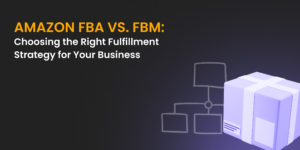In Amazon’s dynamic marketplace, selecting the right fulfillment method—fulfillment by Amazon (FBA) or Fulfillment by Merchant (FBM)—shapes not just logistics and customer service but also impacts scalability and profitability. This comprehensive guide explores the detailed aspects of FBA and FBM, offering insights to help you make an informed decision tailored to your business needs.
Introduction
Choosing the right fulfillment strategy—whether Fulfillment by Amazon (FBA) or Fulfillment by Merchant (FBM)—is essential for Amazon’s success. Each method offers distinct benefits and challenges, influencing how sellers manage inventory, fulfill orders, and interact with customers. This introductory section lays out the primary features and operational impacts of both FBA and FBM, helping you determine which suits your business model best. Understanding these differences is crucial for optimizing your operational efficiency and achieving your sales goals. As we delve deeper, we’ll explore the nuanced benefits and potential drawbacks that come with each fulfillment option, aiming to provide a clear roadmap for your decision-making process.
Key Aspects of FBA (Fulfillment by Amazon)
FBA simplifies operations for sellers by managing the entire supply chain from storage to delivery. By utilizing Amazon’s fulfillment centers, sellers can ensure their products are delivered quickly and reliably to customers worldwide. This service also includes handling customer inquiries and returns, further reducing the burden on sellers. Moreover, FBA products automatically qualify for Amazon Prime, significantly increasing their visibility and appeal to a vast customer base. Ultimately, this can lead to higher sales volumes and improved customer satisfaction due to faster shipping times and trusted Amazon customer service.
How FBA Works
Upon opting for FBA, sellers send their products to Amazon’s fulfillment centers. Here, items are cataloged, stored, and managed until an order is placed. Amazon then takes over the responsibility of packing, shipping, and providing customer service for these orders. This system is designed to streamline the selling process, allowing sellers to focus more on product development and less on logistical complexities.
Benefits of FBA
Fulfillment by Amazon offers a range of compelling advantages for sellers, especially those looking to leverage Amazon’s vast logistical network:
- Scalability: FBA’s infrastructure is designed to handle increased sales volume without additional effort from sellers, allowing businesses to grow without corresponding increases in logistical challenges.
- Prime Eligibility: Products fulfilled by Amazon are eligible for Amazon Prime, which often leads to higher sales due to the attractiveness of fast and free shipping to Prime subscribers.
- Simplified Logistics: With FBA, Amazon handles all logistical operations, including storage, packing, and shipping, which significantly reduces sellers’ complexity.
Enhanced Customer Trust: Having products fulfilled by Amazon increases customer trust due to Amazon’s acclaimed customer service and return policies, enhancing the overall purchase confidence.
Drawbacks of FBA
Despite its numerous benefits, FBA presents several challenges that might deter some sellers:
- Higher Costs: The fees associated with FBA, such as storage and fulfillment fees, can add up, especially for products with slow turnover or large dimensions.
- Less Control: Sellers need to gain more control over the handling and shipping of their products, which can impact custom packaging and other branding efforts.
- Inventory Management: Keeping track of inventory can be more challenging under FBA due to potential discrepancies in stock levels and issues with inventory reconciliation.
- Dependency: Relying heavily on Amazon’s systems means that changes in policy or operational disruptions can have a significant impact on a seller’s business.
Key Aspects of FBM (Fulfillment by Merchant)
With FBM, sellers are in charge of their entire fulfillment process, offering them the flexibility to tailor operations to their specific needs. This control enables them to manage costs effectively, particularly if they have established and efficient logistics systems. Additionally, FBM allows sellers to enhance customer relations through personalized packaging and direct communication, fostering brand loyalty. However, this method requires a robust infrastructure for storing inventory, processing orders, and handling shipping, which can be resource-intensive. Despite these challenges, FBM provides an opportunity for sellers to stand out on Amazon by differentiating their service and product offerings in a competitive marketplace.
How FBM Works
In FBM, sellers list their products on Amazon but take on the responsibility of managing every step of the fulfillment process themselves. This approach demands that sellers maintain their own warehousing solutions and handle all logistics, from packaging to shipping directly to customers. It also requires them to manage customer service, addressing any inquiries or issues that arise post-purchase. FBM can be particularly advantageous for sellers with unique products that require special handling or who wish to maintain tighter quality control. Ultimately, this model allows for greater customization of the customer experience, which can be crucial for building and maintaining a strong brand identity on Amazon.
Benefits of FBM
Opting for Fulfillment by Merchant gives sellers several key advantages:
- Complete Control: Sellers retain full control over their inventory and the entire shipping process, allowing for tailored customer experiences and personalized branding.
- Lower Costs: Efficient fulfillment operations management can result in cost savings compared to FBA, especially if the seller already possesses the necessary logistics infrastructure.
- Brand Presence: Direct customer interaction can strengthen brand presence and build customer loyalty.
- Flexibility: More flexibility in managing inventory, especially for products requiring special handling or with unpredictable sales patterns.
Drawbacks of FBM
While FBM offers greater control, it also comes with its set of challenges:
- Increased Responsibility: Sellers are fully responsible for the logistics of their business, from storage to shipping and customer service, which can be resource-intensive.
- No Prime Eligibility: Products sold under FBM are not automatically eligible for Amazon Prime, which may limit their appeal to Amazon’s large base of Prime subscribers.
- Customer Service Challenges: Managing customer service and returns in-house demands additional resources and expertise, potentially reducing operational efficiency.
- Operational Demands: The need for adequate storage and shipping facilities and the management of these operations can be overwhelming for some sellers, especially during peak periods.
Comparing FBA and FBM
The choice between FBA and FBM should be guided by a seller’s specific needs, capabilities, and business model. FBA is often the preferred choice for sellers leveraging Amazon’s extensive logistics network for faster shipping and access to Prime customers. Conversely, FBM might be more suitable for sellers who require detailed control over their inventory and customer interactions, such as those dealing in large, bulky, or highly specialized products. A hybrid approach, utilizing both FBA and FBM, can provide flexibility, allowing sellers to maximize efficiency by applying the most suitable method for different segments of their inventory. This strategic decision can significantly impact a seller’s ability to scale operations, manage costs, and meet customer expectations effectively.
Decision Factors: When to Choose FBA or FBM
When deciding between FBA and FBM, sellers must carefully evaluate various factors to determine which fulfillment method aligns best with their business goals and operational capabilities. The choice will significantly affect how they manage inventory, interact with customers, and control costs. Each method has its strengths and suits different types of business models and product lines. The following points outline vital considerations that can help sellers make a well-informed decision, balancing efficiency, cost, and customer engagement to optimize their Amazon sales strategy.
- Operational Capacity: Size of your operation and ability to manage logistics.
- Product Characteristics: Type and size of products, including their need for special handling.
- Cost Considerations: Comparison of costs associated with both FBA and FBM.
- Market Strategy: Desired market reach and customer service standards.
Hybrid Approach: Integrating FBA and FBM
The hybrid model represents a strategic compromise, allowing sellers to utilize the strengths of both FBA and FBM. By using FBA for high-demand items that benefit from Amazon Prime and faster shipping, sellers can enhance customer satisfaction and potentially increase sales. For products that require specific care and customization or have lower turnover rates, FBM offers the necessary control over the fulfillment process. This approach ensures that sellers can adapt quickly to changes in demand or product specifications without compromising on service quality. Ultimately, the hybrid model provides a balanced solution, optimizing logistics while maintaining flexibility in inventory management.
Summary and Final Thoughts on Fulfillment Strategies
Selecting the appropriate fulfillment strategy is essential for maximizing operational efficiency and aligning with customer expectations on Amazon. FBA offers ease and reach, making it ideal for sellers who prioritize growth and customer reach without the hassle of handling logistics. FBM, on the other hand, appeals to sellers who value control over their operations and direct customer engagement. By carefully assessing their specific circumstances, sellers can choose a strategy that best supports their business model and growth objectives. In conclusion, whether opting for FBA, FBM, or a combination of both, the right choice hinges on understanding and reacting to the unique demands of your business and market conditions.
For more insights on optimizing your Amazon business strategy, visit Profit Whales. If you have specific inquiries or need tailored advice, feel free to contact us.
FAQ
How do return policies differ between FBA and FBM?
FBA handles returns directly, providing a seamless return process for customers, which enhances customer trust and satisfaction. In contrast, FBM sellers are responsible for managing returns, which can vary in efficiency depending on their policies and systems.
Can sellers use both FBA and FBM for different products in their inventory?
Yes, sellers can choose to use FBA for some products and FBM for others, allowing them to balance control and convenience across their product range.
What strategies can FBM sellers use to compete with the Prime badge on FBA listings?
FBM sellers can offer competitive pricing, exceptional customer service, and unique product offerings. Additionally, engaging in Amazon’s Seller Fulfilled Prime program can help achieve Prime status while maintaining control over fulfillment.
Are there specific product categories that benefit more from FBA than FBM, or vice versa?
Products with high sales volumes and smaller sizes typically benefit more from FBA due to the Prime eligibility and shipping efficiency. Conversely, niche products, large items, or those requiring special handling may benefit from FBM.
How quickly can sellers switch between FBA and FBM if their business needs change?
Sellers can switch between FBA and FBM relatively quickly, depending on their inventory management and the operational adjustments required. It’s essential to monitor performance metrics and market demands to decide when a switch might be beneficial.








